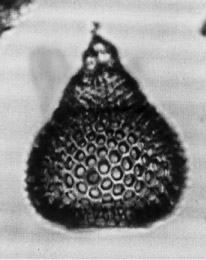 Theocotyle
venezuelensis Riedel and Sanfilippo
Theocotyle
venezuelensis Riedel and Sanfilippo Theocotyle
venezuelensis Riedel and Sanfilippo
Theocotyle
venezuelensis Riedel and SanfilippoTheocotyle venezuelensis Riedel and Sanfilippo, 1970, p.525, pl.6, figs.9-10, pl.7, figs.1-2; Sanfilippo and Riedel, 1982, p.179, pl.2, figs.8-12 (with synonymy)
General form subconical to inflated, with distinct collar and lumbar strictures (see illustrations accompanying original description for range of morphologies). Cephalis subspherical, its wall often including arches directed toward primary laterals from apical bar, with few small pores and apical horn of approximately same length. Thorax hemispherical, with circular pores. Abdomen inflated, with larger circular pores, much wider than thorax and with constricted mouth, terminated by distinct peristome. Late specimens considerably larger than earlier ones, with thorax relatively smaller. Surface of thorax and abdomen rough (Sanfilippo and Riedel, 1982).
Based on 40 specimens. Total length excluding horn 155-285 µm, of thorax 40-45 µm, of abdomen 115-200 µm. Maximum width 125-245 µm (Sanfilippo and Riedel, 1982).
T. venezuelensis is distinguished from T. cryptocephala and T. conica by a more pronounced lumbar stricture and more inflated abdomen, and from Theocotylissa ficus by its larger abdominal pores, generally thinner wall and hemispherical rather than conical thorax. A very similar, earlier form of uncertain affinity, but with less regularly arranged abdominal pores and larger mouth, occurs in DSDP 40-14-3 (Buryella clinata Zone). Late specimens of Theocotyle venezuelensis with large inflated abdomen and relatively smaller thorax, resemble Theocotylissa ficus (Sanfilippo et al., 1985). This causes some problems of identification particularly in the tropical Pacific (DSDP Sites 40 and 162), where T. ficus becomes extremely rare near the base of the Thyrsocyrtis triacantha Zone, and at the same time large specimens of Theocotyle venezuelensis are particularly abundant (Sanfilippo and Riedel, 1982).
Subconical to inflated, three-segmented form, with distinct collar and lumbar strictures. The wall of the cephalis often includes arches directed toward the primary laterals from the apical bar. The thorax varies from hemispherical to inflated-conical, and the abdomen from inflated-annular to inflated-conical. Through time, the thorax decreases in size and the abdomen increases. Late specimens are much larger (maximum length excluding horn 255-285 µm, maximum width 215-245 µm) than early ones (maximum length excluding horn 155-215 µm, maximum width 125-195 µm) (Sanfilippo et al., 1985).
Although this form is found in most tropical assemblages of early middle Eocene age, the Indian Ocean samples contain only forms with thicker than normal shell walls obscuring the characteristic lumbar stricture. Its morphotypic first appearance lies within the Theocotyle cryptocephala Zone. Its morphotypic last appearance is approximately synchronous with the lower limit of the Podocyrtis ampla Zone.
Theocotyle venezuelensis appears to be an evolutionary offshoot from T. cryptocephala, and it left no descendants.
Additional illustrations can be found in Moore, 1971, pl.1, fig.11.